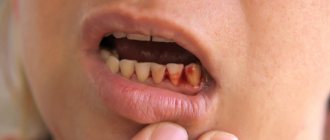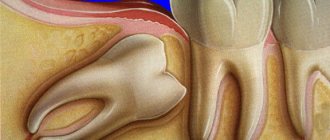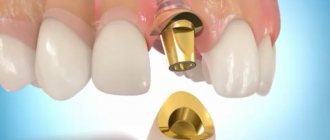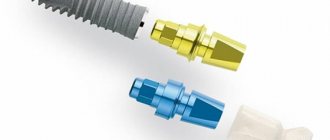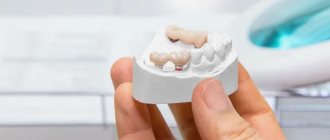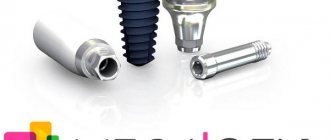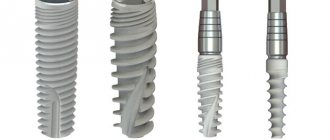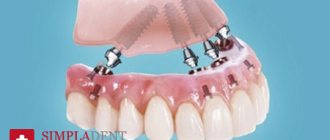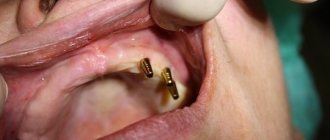- Each implant comes complete with a plug
- The choice of diameter and length of the implant depends on the volume of bone tissue in the patient and the expected occlusal load
- For aesthetic reasons, Bicon implants are designed to be placed deeper than the cortical plate of the alveolar ridge so as to be 5mm below the level of the gum on the vestibular side.
- Implants can also be placed flush or slightly above the ridge if this does not affect subsequent esthetics.
- As a general recommendation, choose the widest possible implant, not necessarily the longest one.
- In the anterior part of the upper jaw, we recommend using implants with an internal diameter of 2.5 mm
- In the chewing region up to the canine, it is recommended to install one implant per tooth, if conditions allow.
- Become familiar with the depth notches on the 2.0mm pilot bur and blade cutters.
Features of the Bicon implant
Any implant system has certain features and differences. The characteristic features that distinguish Bicon implants from similar products include the following:
- The length of Bicon titanium rods is no more than 8 millimeters, while products from other manufacturers are twice as long;
- the area of the implants is approximately three times larger in comparison with analogues due to the increased width of the rod, which ensures their correspondingly higher resistance to external loads and their reliable fastening in the jaw with a short screw length;
- good survival rate is ensured by excellent biocompatibility with bone tissue and high quality titanium alloy;
- due to the small size of Baikon implants, they minimize the risk of damage to bone tissue and gums;
- fixing the system is quite simple; when installing them, there is no need to use special tools or cut tissue;
- There are no fasteners or screws in the mouth, which makes oral care easier and improves hygiene.
Due to their small size, Bicon systems, in comparison with analogues, are distinguished by much higher reliability, stability and stability.
Features and benefits of Bicon implants
Implants are made from high-tech titanium surgical alloy, coated with a special composition for the most reliable and rapid healing. The materials used in the production of prostheses are biologically compatible and the likelihood of rejection is minimal and in practice such cases have not been recorded.
Compared to traditional dentures, the special coating of these implants over time does not form a dark metal strip in the cervical part of the gum, which usually happens when installing metal ceramics.
In general, it is the excellent design and aesthetics that have brought the prosthetics of this company to the forefront. They differ in appearance from natural teeth and do not require any special care. Only extreme situations, such as facial injuries, can affect longevity.
Thanks to bacterial-tight connections, Bicon implants are very durable and reliable, which sets them apart from more conventional types of dentures.
The advantage of these implants is that they can be installed either immediately after tooth extraction or over time, if the height of the jaw bone allows. But the special design of these implants still places lower bone height requirements than conventional dentures. In most cases, this helps to avoid unnecessary bone augmentation operations.
In addition, implants from an American company avoid the removal of healthy nerves to restore a tooth.
Types (models) of Baikon implants
Depending on the diameter, length and connection with the Bicon abutment, implants, the price of which is quite affordable, are divided into three model groups:
- Short series. Rod length 8-11 mm, internal connection 3.0 mm, diameter 4.5-6.0 mm. Such products are the smallest in length. They are designed in the form of a cone-shaped connection, completely immersed in the bone tissue, without touching the alveolar nerves. Prevents bacteria from entering the tooth socket;
- Max 2.5 series. Length 8-11 mm, connection to abutment 2.5 mm, diameter 4-4.5 mm. The model is designed for implantation into the front part of the jaw, but installation in other areas is not excluded. The design has a cone shape. There is the possibility of re-implantation if necessary;
- Narrow series. 8-11 mm – length, 2.0 mm – internal connection, 3-4.5 mm – diameter. Designed for installation on the lower jaw in the front part with a small space between the teeth.
Types of Dental Implants
Modern implantology uses root-shaped implantation systems in practice - cone-shaped or cylindrical. This form is identical to the anatomy of a natural tooth root and involves low-traumatic installation and rapid osseointegration (engraftment).
- Cone-shaped models are mainly used in one-stage implantation protocols and for installation in soft bone tissue (class D3, D4). The tapered shape provides better initial stabilization of the artificial root in the jawbone.
- Cylindrical dental implants are used in the classic two-stage protocol, as well as for implantation into hard, rigid bone of type D1, D2.
According to their structural structure, implants can be two- or one-piece. The first ones consist of two elements - the intraosseous part (artificial root) and the abutment (transitional element on which the prosthesis is fixed). The second is a model where the implant and abutment are one structure.
There are other models of artificial roots that are no longer used in modern implantation protocols because they are technically outdated - disk, plate, combined, etc. Some clinics still use them in practice, but the disadvantages of the design outweigh the possible advantages of their installation.
Advantages of Baikon implants
The main advantage of Bicon brand implants is that there is no need to build up bone tissue when installing them. The titanium root takes root in an extremely short time and remains securely fixed.
The list of advantages of Baikon systems is quite impressive. Among the main ones note:
- compared to conventional dentures, installation of Bicon rods takes much less time;
- The titanium root does not cause any complications after implantation;
- artificial teeth are reliable in operation and visually aesthetically attractive;
- the prosthesis is fixed immediately after its installation and does not cause any discomfort to the patient;
- during the implantation process, the risks of damage to soft tissues are minimal;
- installation can be carried out using a two-stage or one-stage method.
Another advantage that sets Baikon implants apart from analogues is the price, which is much lower than prostheses of other brands. The quality of the implants is highly appreciated by doctors and consumers all over the world. Numerous reviews are direct confirmation of their reliability and impeccability.
Implant installation procedure
The implantation process takes no more than one hour and is carried out under local anesthesia. As a rule, immediately after installing the prosthesis, a fixed restoration is made while the tooth heals, so that the patient will have to experience discomfort during this period due to the absence of a tooth.
Temporary restoration allows, firstly, to preserve aesthetics, and secondly, it completely restores the functionality of the tooth. It reliably stabilizes the implants during healing.
After tooth extraction, a special abutment is installed on it, which promotes rapid healing of the soft tissue around the implant. After 3-6 months, when the tissues have completely healed, the temporary abutment is replaced with a permanent one, and the final restoration is attached to it.
To completely restore a tooth or a full row, just three visits to the dentist are enough. How long the whole process will take can be predicted only after an examination by a dentist. If there is a serious lack of bone tissue, then osteoplasty will have to be done, and the process will take about a year. But thanks to Bicon’s thoughtful solutions, the patient will not experience any discomfort during this period.
Rehabilitation after surgery
The first thing that is necessary after implantation is to follow the doctor’s recommendations and maintain oral hygiene. Immediately after surgery, the patient may experience moderate pain, but this is completely natural. Usually after three days the pain disappears.
In the postoperative period, it is very important to monitor the strength of the fastenings, and if even slight mobility is observed, then you should immediately consult a doctor for more reliable fixation and elimination of defects.
Rating of dental implants
The rating is based on implantation systems popular in the Russian Federation. When compiling, the results of clinical studies, the opinions of doctors and patient reviews were taken into account. It is difficult to determine which of them is better, since many are equivalent in quality, properties and cost.
TOP 10 best implantation systems
| Brand | Surface Features | Survival rate | Segment |
| Nobel Biocare (USA) | Active hydrophilic TiUltra surface coated with phosphorus ions | close to 100% | premium |
| Straumann (Switzerland) | SLActive surface with hydrophilic properties | 97-99, 2% | premium |
| Astra Tech (Sweden) | OsseoSpeed surface, active hydrophilic, coated with fluorine ions | Close to 100% | premium |
| Ankylos (Germany) | Microporous surface Firadent Plus | Close to 100% | average |
| Impro (Germany) | Microporous surface SuperH | 96-98% | average |
| Biohorizons (USA) | Patented Laser-Lok surface | 97-97,3% | average |
| Osstem (South Korea) | Porous surface SA and CA | 96-98% | economy |
| Alpha Bio (Israel) | Microporous Nano Tec surface | 97-98,3% | economy |
| Dentium (South Korea) | SLA surface with moderate hydrophilic properties | 96-98,8% | economy |
| Dentium Implantium (South Korea) | SLA surface with moderate hydrophilic properties | 97,5% | economy |
When choosing an implantation system, the following criteria are taken into account:
- Material;
- shape, carving;
- osseointegration time;
- surface type;
- survival rate;
- the lineup;
- manufacturer's warranty.
The survival rate of an implantation system can be classified as conditional criteria, since clinical experience shows that the survival rate of installed implants with proper care reaches 100%, regardless of the popularity of the brand. This indicator largely depends not on the brand, but on the experience of the implantologist and the actions of the patient (we are certainly not talking about fakes or products of dubious quality).
The average survival time of an artificial root is 3 months on the lower jaw, 6 months on the upper jaw. For premium systems, the period of osseointegration is reduced to 1.5-3 months. The manufacturer provides a guarantee for the implants, but not for their service life. The performance of economy systems is close to 15-20 years, while premium systems have a lifetime warranty.
Indications and contraindications
As the manufacturer reports on the official website, Bicon implants are suitable in cases where it is necessary to perform prosthetics as quickly as possible. They are used for standard prosthetics and are suitable for those patients who have an increased risk of complications due to the characteristics of the body.
Using the Baikon system, it is possible to carry out prosthetics without waiting for tissue healing after amputation of a tooth or root. Implants are irreplaceable when the amount of bone tissue is too small to allow the use of products from other manufacturers.
There are no absolute contraindications to the use of Bicon implants. But there are relative cases in which restoration of the dentition is not recommended. These include:
- problematic condition of the oral cavity;
- nervous disorders;
- mental illness;
- diseases that have a viral or infectious etiology;
- caries;
- diseases of the teeth and gums that have developed due to poor oral care;
- chronic pathologies affecting internal organs (the possibility of prosthetics is determined individually);
- impossibility of using anesthetics due to intolerance or medical reasons;
- hypersensitivity to titanium.
Many of the contraindications are removable, so in each case you need to make a decision only after consulting with your dentist.
Materials for the manufacture of implants
In the manufacture of implant systems, metals are used that are resistant to corrosion processes, electrochemical reactions, and biocompatible with periodontal tissues. Such materials include titanium, its alloys, tantalum, and non-metallic materials. The main part of implantation systems is made of titanium. It is a durable, lightweight metal, corrosion-resistant, bioinert, around which bone tissue quickly forms.
Manufacturers use different grades of titanium. Russian manufacturers use purified titanium grades VT 1-0 and VT 1-00 (GOST 19807-91). Foreign companies use 4 grades of titanium (Grade 1−4 ASTM, ISO) and titanium alloy Ti-6Al−4V (ASTM, ISO) - an analogue of the Russian VT-6. The materials differ in mechanical properties and chemical composition.
The purer the material, the higher the rate of survival of the artificial root, its compatibility with nearby tissues, and primary stability in the bone. This factor also minimizes the risk of developing allergies. It is this pure, unalloyed titanium (Grade 4) that premium class implant manufacturers use.

